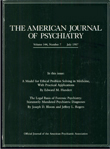SSRI Discontinuation and Buspirone
To the Editor: Recently, there has been a greater awareness of selective serotonin reuptake inhibitor (SSRI) discontinuation syndrome, which can appear with both somatic and psychological symptoms (1). Symptoms appear within 1–3 days after the last dose and are usually mild and transient, although they can be more severely distressing. We report on a patient who developed SSRI discontinuation syndrome and experienced an intensification of the symptoms after an attempt to relieve them with buspirone.
Ms. A, a 62-year-old woman, initially came to our clinic with a 3-year history of depression and associated features of anxiety. She had previously been treated with amitriptyline and had experienced only partial response; she had also taken buspirone for anxiety. She began taking sertraline, 50 mg/day, and subsequently increased the dose to 100 mg/day. At 6 weeks, she had a partial response to sertraline and mild side effects of dizziness and nausea. One month later, she reported additional improvement, most notably in decreased sadness and pessimism. Her side effects had disappeared. At the 5-month follow-up, her depression was in full remission, and she was experiencing no side effects.
Six weeks later, she came to the clinic on an emergency basis with intense nausea, anxiety, dizziness, and vertigo. Four days before, she had abruptly stopped taking sertraline because of problems with refilling her prescription. On the third day of symptoms, she had decided to treat the anxiety and dizziness with buspirone, 15 mg/day. She experienced an exacerbation of symptoms shortly after this, which led to her coming to the clinic. She was again given sertraline, 100 mg/day; her symptoms disappeared within 24 hours.
During long-term SSRI administration, there is a greater concentration of synaptic serotonin, which causes autoreceptors and postsynaptic receptors to desensitize or down-regulate (2). With abrupt cessation of serotonin blockade, there may be a temporary deficiency of available synaptic serotonin in the face of these down-regulated receptors. It has been proposed that the symptoms observed during discontinuation syndrome are the result of a deficiency in these serotonin pathways (3). Buspirone, a partial agonist, may have exacerbated the patient’s symptoms because of some weak or partial net antagonist properties. Furthermore, since one of buspirone’s proposed effects is the partial activation of the serotonin 5-HT1A autoreceptor (purportedly resulting in decreased serotonergic transmission), synaptic serotonin concentrations may have been further decreased (4). It is possible that this patient, who decided to treat her discontinuation syndrome with buspirone, may have exacerbated her symptoms by continuing to block serotonergic transmission.
1. Schatzberg AF, Haddad P, Kaplan EM, Lejoyeux M, Rosenbaum JF, Young AH, Zajecka J: Serotonin reuptake inhibitor discontinuation syndrome: a hypothetical definition: discontinuation consensus panel. J Clin Psychiatry 1997; 58(suppl 7):5–10Google Scholar
2. Goodwin GM: How do antidepressants affect serotonin receptors? the role of serotonin receptors in the therapeutic and side effect profile of the SSRIs. J Clin Psychiatry 1996; 57(suppl 4):9–13Google Scholar
3. Lane RM: Withdrawal symptoms after discontinuation of selective serotonin reuptake inhibitors (SSRIs). J Serotonin Res 1996; 3:75–83Google Scholar
4. Glitz DA, Pohl R:5-HT1A partial agonists: what is their future? Drugs 1991; 41:11–18Google Scholar



